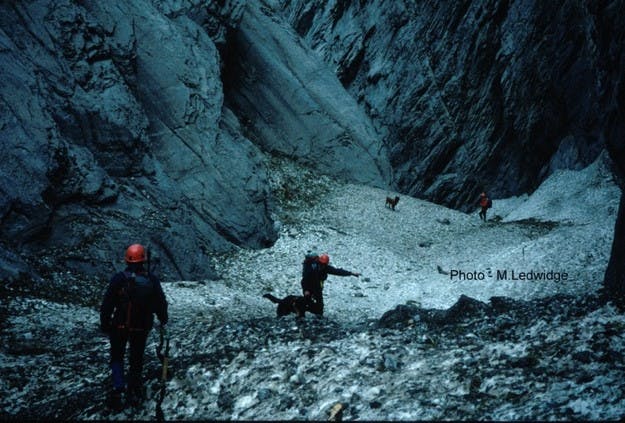Cascade Mountain
WI2, WI5 for direct finish, 100-150m
ATES class 4 (extreme)
First climbed in 1969, Urs Hole has roughly five pitches of moderate climbing followed by a direct finish that can be as hard as WI5. Due to its direct position under a large avalanche path, it is primarily climbed in the fall before there is much snowfall. There is often a glacier feature snow plug that lies before the last direct finish pitch due to the copious amounts of debris that piles up there.
Popularity
- 14 people filled out the survey
- 93% climbed it 1–5 times
- 7% climbed it 6–10 times

- Credit
- Grant Statham
Avalanche frequency
- 36% have seen debris on the climb
- 64% have not seen debris on the climb
- Only one person noted seeing an avalanche on Urs Hole from the road
Time of year and day
Seven climbed the route from December to January, three climbed it from October to November, and three climbed it from February to April.
Avalanche start zones:
- 80% believe the avalanche started well above the climb.
- 20% believe it started just above the climb.
Runout debris
- 36% have seen debris at the base of the climb or lower
- 43% have seen debris in the middle pitches of the climb
- 14% have seen debris at the top of the climb
- 7% saw the pocket glacier debris
- 36% have never seen debris
Notes on Avalanche Debris:
- Depending on the month, all the way to the bottom and beyond (a few noted this, and more likely in spring).
- Always the ice cave debris plug before the final pitches (noted by many).
- Middle pitches of Urs, two years ago.
- Two people mentioned seeing huge debris in December.
Reported avalanches and incidents:
- Feb. 4, 1995: Two climbers were hit and killed by an avalanche in Urs Hole. Unseasonably mild and stormy conditions were predicted for the day and a drizzle set in around noon and continued into the next day. The climbers started after mid-morning and likely reached the key pitch up the gully after the rain began. One of the bodies was found the next day hanging by his harness at the anchor. The double rope was hanging nearby. His equipment was all gone but he appeared relatively uninjured and it was speculated he died partly from hypothermia. The other climber was found in July after being buried under 10 metres of debris. He may have been rappelling at the time and was swept from the ropes.
- One person noted seeing an avalanche over Urs Hole from the road

- Credit
- M. Ledwidge
The debris pile is searched months after an avalanche struck and killed two climbers in Urs Hole.
Contributing factors:
- New snow amounts: 80%
- Winds: 80%
- Solar radiation and warming: 40%
Summary:
- Urs Hole lies directly under the main south face of Cascade Mountain.
- Once in the gully there is little chance of escaping an avalanche should one occur.
- Very large avalanches have been recorded here, enough to leave an almost permanent glacier plug in the gully.
- Most climbers consider climbing this route only before snow amounts are at threshold for avalanches.
- It is well known amongst the community that this climb has serious exposure and risk to avalanches once the slopes above hold snow.